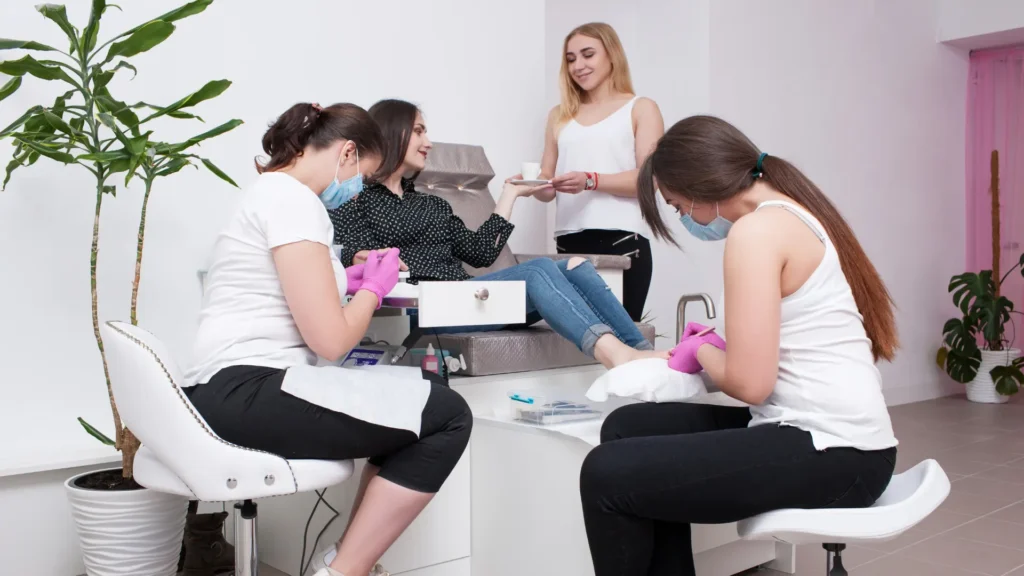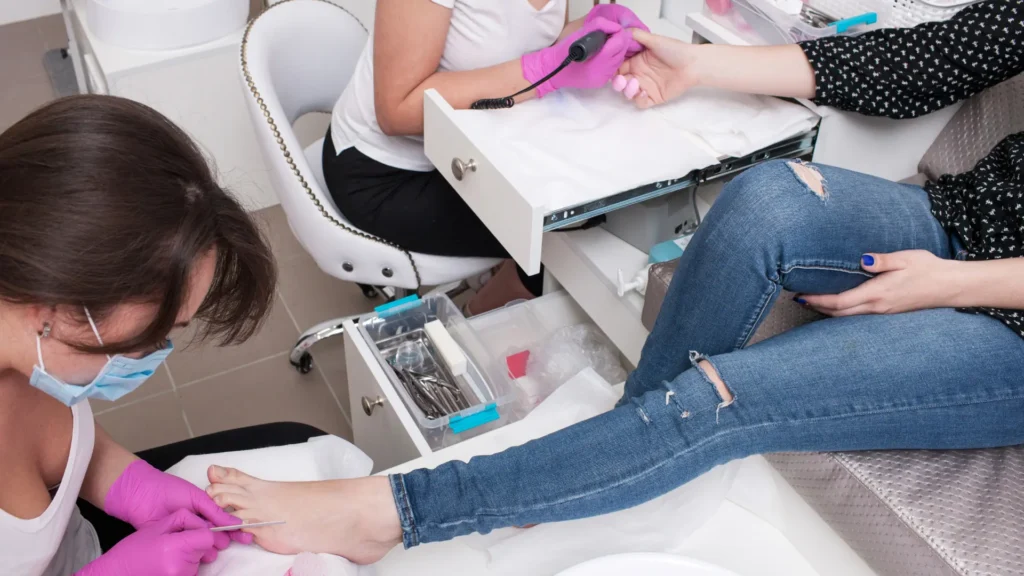In this comprehensive blog post on ‘Do Manicure and Pedicure Hurt? A Comprehensive Guide for Clients,’ you’ll discover:
- What do manicure and pedicure services entail, and why do they matter?
- Factors that influence pain perception during nail care treatments.
- Practical tips to minimize any discomfort and ensure a pleasant experience.
If you’re curious whether getting a manicure or pedicure hurts, keep reading to uncover the answers and insights that will make your next nail care appointment a breeze!
Quick Answer To: Do Manicure and Pedicure Hurt?
No, manicures and pedicures are generally not painful experiences, but individual sensitivity and nail health can influence your comfort level. Communication with your technician is key to ensuring a pleasant experience, and proper preparation, salon selection, and home care can minimize discomfort. Remember, these treatments are meant to be enjoyable and beneficial for your nails, so go ahead and schedule your next appointment for some well-deserved self-care.
Jump To:
Understanding the Manicure and Pedicure Process
Alright, now that I’ve got your attention, let’s delve into the fascinating world of manicures and pedicures. These are more than just nail treatments – they’re a delightful way to pamper yourself and keep your nails looking their best.
What Are Manicure and Pedicure Services?
Let’s start with the basics. Manicures and pedicures are spa treatments focusing on your nails, hands, and feet. They’re not just about making your nails look pretty (although that’s a bonus); they’re about keeping them healthy and well-groomed.

Common Steps Involved in Manicure and Pedicure
1. Nail Cleaning
First things first, your technician will clean your nails thoroughly. This ensures your nails are free from dirt, oils, and any existing nail polish.
2. Cuticle Care
Cuticles are the delicate skin around your nails. Technicians gently push back or trim your cuticles to keep them neat and healthy.
3. Nail Shaping
Say goodbye to uneven nails! Your technician will shape your nails according to your preferences, whether you like them square, round, or something in between.
4. Exfoliation (for Pedicures)
If you treat yourself to a pedicure, you’ll experience a luxurious foot exfoliation. It helps remove dead skin cells, leaving your feet soft and smooth.
5. Moisturizing
Dry hands and feet? Not anymore! Your technician will apply moisturizer to keep your skin hydrated and healthy.
Note: Still Unsure How Long Your Manicure Should Take? Don’t Worry! I’ve Written A Helpful Guide On Recommended Manicure Duration That Breaks Down The Average Time For Each Step. Give It A Read To Better Plan For Your Next Appointment.
The Importance of Proper Nail Care
Manicures and pedicures are not just about aesthetics. They play a crucial role in maintaining the health of your nails. Regular nail care can prevent issues like hangnails, split nails, and fungal infections.
So, don’t just think of manicures and pedicures as a beauty treatment – they’re also a way to keep your nails in tip-top shape. Now that we’ve covered the basics, let’s explore whether these treatments hurt and what factors can influence your experience.

Potential Discomfort During Manicures and Pedicures
Now, let’s take a closer look at the potential sources of discomfort during manicures and pedicures. Remember, discomfort doesn’t necessarily mean pain, but addressing your worries is essential.
Nail Sensitivity
One common source of discomfort is nail sensitivity. Certain parts of the manicure or pedicure process may feel slightly uncomfortable if your nails are sensitive or have any existing issues like hangnails or ingrown nails.
Cuticle Care Sensations
Cuticle care involves gently pushing back or trimming the cuticles around your nails. While technicians aim to be gentle, you may feel a slight sensation during this step. If you’re sensitive in this area, it’s essential to communicate with your technician.
Nail Shaping Concerns
Nail shaping is usually painless, but you might worry about it if you have specific preferences or concerns. Rest assured that nail technicians are trained to shape your nails precisely and with care, ensuring a comfortable experience.
Scrubs and Exfoliation (for Pedicures)
If you’re getting a pedicure, the exfoliation process can initially feel a bit precarious or strange. The scrubbing sensation is meant to remove dead skin cells and is not typically painful.
Addressing Common Worries
1. Painful Tools
You might have heard stories about painful tools used during manicures and pedicures. Choosing a reputable salon where technicians use sanitized and well-maintained tools is essential. Don’t hesitate to speak up if something feels sharp or uncomfortable.
2. Ingrown Nails
Ingrown nails can be a cause for concern. However, a skilled technician can address ingrown nails without causing excessive pain. If you’re prone to ingrown nails, let your technician know so they can take extra care.
Tips for Managing Discomfort
Here are some tips to help you manage any potential discomfort during your nail care treatments:
- Proper Preparation: Maintain good nail hygiene and moisturize your nails before your appointment.
- Choose the Right Salon: Research a reputable salon with experienced technicians.
- Communication: Don’t be shy about communicating with your technician. Let them know about any concerns or sensitivities you have.
- Relax: Try to relax and enjoy the pampering experience. The more relaxed you are, the less discomfort you’ll likely feel.
Remember, manicures and pedicures aim to make your nails look and feel fantastic. Discomfort should be minimal, and by following these tips, you can have a comfortable and enjoyable nail care experience.

Pain Perception and Factors
Let’s discuss the big question: Does getting a manicure or pedicure hurt? The answer isn’t a simple yes or no because it depends on several factors, and everyone’s pain threshold differs.
Understanding Pain Thresholds
First, let’s get one thing straight – pain is subjective. What may be painful for one person might not bother another at all. It all comes down to your pain threshold, which is how much you can tolerate.
Some people have high pain thresholds and can handle more discomfort, while others are more sensitive to even the slightest twinge. So, remember that your experience may vary from someone else’s.
Note: Puzzled About The Standard Time For A Pedicure? Check Out My Guide On Typical Pedicure Duration That Provides A Detailed Breakdown Of The Time For Each Part of The Process. It’s A Great Resource To Set Expectations Before Your Next Pedi.
Factors That Can Influence Pain Perception
Various factors can influence your pain perception during a manicure or pedicure. Let’s take a closer look at what might play a role:
1. Individual Sensitivity
As mentioned earlier, your pain threshold is unique to you. You might feel more discomfort during certain parts of the nail care process if you’re generally sensitive to pain.
2. Nail Health
The condition of your nails can also impact your experience. You will likely have a smoother and less painful experience if your nails are healthy and well-maintained.
3. Salon Techniques
The techniques used by the nail technician can make a significant difference. A skilled and experienced technician knows how to minimize discomfort while providing excellent nail care.
Importance of Open Communication with the Technician
Here’s the good news: You don’t have to suffer in silence. Communication with your nail technician is key. Don’t hesitate to let them know if something doesn’t feel right or is causing you pain. They can adjust their approach to make your experience more comfortable.
So, the bottom line is that while some people may experience mild discomfort during certain parts of a manicure or pedicure, it’s not meant to be a painful process. Proper communication and understanding of your unique pain threshold allow you to enjoy your nail care treatments easily.
How to Minimize the Pain and Discomfort During Manicure and Pedicure?
Now that you know what to expect and how to communicate with your nail technician, let’s dive into some practical steps to minimize pain or discomfort during your manicure or pedicure appointment. Preparation is key!
Proper Preparation Before the Appointment
1. Nail Maintenance
Before heading to the salon, ensure your nails are clean and free from any existing nail polish. Trim your nails if needed, but don’t cut them too short. Short nails can sometimes be more sensitive.
2. Hydration
Keep your skin well-hydrated in the days leading up to your appointment. Moisturized skin is less prone to discomfort during the exfoliation and massage stages.
Salon Selection and Technician Qualifications
Choosing the right salon and technician can improve your nail care experience. Here’s what to look for:
- Reputation: Read reviews and ask for recommendations from friends to find a reputable salon.
- Technician Qualifications: Ensure your technician is trained and experienced in providing manicures and pedicures.
- Sanitization: Check that the salon follows strict sanitization protocols for tools and equipment.
Communication During the Appointment
Don’t hesitate to communicate with your technician throughout the appointment. They want you to have a positive experience, so let them know that your input matters if anything feels uncomfortable, whether it’s nail shaping or cuticle care.
Home Care After the Manicure/Pedicure
To maintain the results of your nail care treatment and prevent discomfort later, follow these home care tips:
- Keep Moisturizing: Regularly moisturize your hands and feet to prevent dryness.
- Avoid Harsh Chemicals: Be cautious with household cleaning products, as they can affect your nail polish and overall nail health.
- Nail Protection: Consider wearing gloves when doing chores or using your hands in harsh conditions.
- Nail Polish Maintenance: If you opt for nail polish, touch up any chips to avoid uneven surfaces that can cause discomfort.
Recognizing Signs of Infection or Excessive Pain
While discomfort during a manicure or pedicure is normal, it should never be excruciating. If you experience severe pain or bleeding or notice signs of infection (redness, swelling, or pus), it’s crucial to seek medical attention immediately.
Following these tips and taking good care of your nails between appointments can ensure a comfortable and enjoyable manicure or pedicure experience. Remember, it’s all about self-care and keeping your nails looking their best.
FAQs
Do first-time manicures hurt?
First-time manicures typically don’t hurt. Nail technicians are trained to provide gentle and comfortable services. If you’re nervous, communicate with your technician, and they will ensure a pain-free experience.
Is it painful to get a nail manicure?
Nail manicures are generally not painful. You may feel some mild sensations during specific steps like cuticle care or nail shaping, but it should not be painful. If you experience excessive pain, communicate with your technician.
How can I make my pedicure less painful?
To make your pedicure less painful, follow these tips:
- Choose a reputable salon with experienced technicians.
- Communicate any concerns or sensitivities with your technician.
- Keep your feet well-hydrated and moisturized before the appointment.
- Relax and enjoy the experience to minimize discomfort.
Why do they hit your legs during a pedicure?
During a pedicure, technicians often tap or massage your legs and feet. This is done to promote circulation, relax the muscles, and enhance the overall spa experience. It should not be painful and is meant to be soothing. If it feels uncomfortable, let your technician know, and they can adjust their technique.
Final words for Do Manicure and Pedicure Hurt?
Congratulations! You’ve made it through our comprehensive guide on whether manicures and pedicures hurt. I hope this guide has eased any concerns you may have had and provided you with valuable insights into nail care.
In summary, here’s what we’ve covered:
- Manicures and pedicures are spa treatments that focus on nail health and grooming.
- Pain perception varies from person to person, but these treatments are generally not painful.
- Factors like individual sensitivity and nail health can influence your experience.
- Communication with your technician is essential to ensure a comfortable experience.
- Proper preparation, salon selection, and home care can minimize discomfort.
- Recognize the signs of infection or excessive pain and seek help if needed.
Remember, manicures and pedicures are meant to be enjoyable and beneficial experiences. They can boost your confidence and help you maintain healthy nails.
So, don’t hesitate to schedule your next appointment and treat yourself to well-deserved self-care. Whether it’s a special occasion or just a day to pamper yourself, nail care is a fantastic way to indulge.






